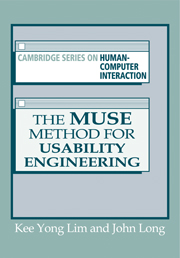
-
Select format
-
- Publisher:
- Cambridge University Press
- Publication date:
- May 2010
- November 1994
- ISBN:
- 9780511624230
- 9780521474948
- 9780521479998
- Dimensions:
- (253 x 177 mm)
- Weight & Pages:
- 0.842kg, 352 Pages
- Dimensions:
- (244 x 170 mm)
- Weight & Pages:
- 0.56kg, 352 Pages
You may already have access via personal or institutional login
Book description
When this book was first published, recent aspects of human factors research had led to methodologies that integrated usability into the development of interactive systems. MUSE was one of the pioneering methods for Usability Engineering. It provides an environment in which human factors contributions can realise their full potential. MUSE supports active human factors involvement in both design specification and evaluation, and takes system development from user requirements to user interface design. Its methods describe how design errors can be avoided or rectified throughout system development, as well as showing how errors can be identified and providing support for inter-disciplinary design planning and coordination. It therefore ranks as one of the best developed and most completely structured human factors methods. This book reviews the motivation for developing MUSE, and provides readers with a manual for method application. It will be essential reading for all involved with systems development, whether from the HCI or software engineering communities, and can be used as well for course accompaniment.
Reviews
"This extrapolation of a structured human factors method may mark a watershed in usability engineering approaches to design." John F. Meech and Raymond Devlin, Ergonomics
Contents
Metrics
Full text views
Full text views help Loading metrics...
Loading metrics...
* Views captured on Cambridge Core between #date#. This data will be updated every 24 hours.
Usage data cannot currently be displayed.
Accessibility standard: Unknown
Why this information is here
This section outlines the accessibility features of this content - including support for screen readers, full keyboard navigation and high-contrast display options. This may not be relevant for you.
Accessibility Information
Accessibility compliance for the PDF of this book is currently unknown and may be updated in the future.


